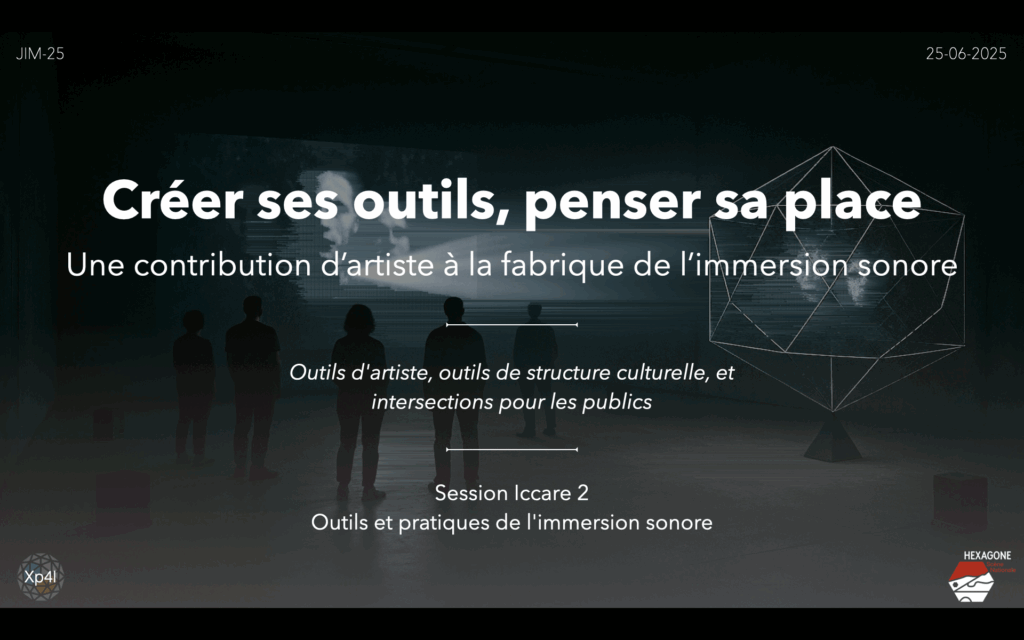Building Tools, Claiming Space: Toward an Artistic Ecology of Immersive Sound

Introduction
As part of my collaboration with L’Hexagone Scène Nationale, I was invited to speak at the 2025 Journées d’Informatique Musicale (JIM), in the PEPR ICCARE panel. My role was to present my experience developing artist-built tools for immersive sound, and to reflect on what this approach means — both artistically and politically.
During the event, I was asked to present my experience as an artist developing a tool for immersive sound creation: Xp for Live. This was not a technical demonstration. Rather, it was an opportunity to reflect on a deeper gesture — one that is both aesthetic and political.
Indeed, building your own creative tools as an artist is not only about control. It’s also about reclaiming a voice within a field that is often structured without artists. It allows us to take part in shaping the narrative of immersive sound, while contributing to the way this practice is being defined, named, and shared.
1. The Tool as an Extension of Artistic Gesture
Xp emerged from a vital need: to reclaim a creative space that truly reflected my process. At first, this appeared as a vague discomfort — a growing mismatch between existing tools and my sonic language. Later, this feeling sharpened into a clear intention. Creating artist-built tools for immersive sound became a way to reclaim not only the workflow, but the underlying artistic philosophy shaping it
It wasn’t just about using tools differently. More importantly, it was about contributing to the narrative behind them. Creating Xp allowed me to regain control over the hidden grammar of sound creation. Moreover, by sharing the tool, I could also share my ideas, my methods, and my artistic worldview. After all, agency begins with distribution. When you share a tool, you also share a philosophy.
2. Development as an Act of Resistance
Creating Xp also meant rejecting a top-down system. In this system, artists are treated as end-users, demonstrators, or passive participants. Instead, I wanted to resist the automatic alignment with capitalist innovation — a logic where tools are reduced to products, meant to be monetized, updated, and integrated into profit-driven chains.
By building my own tool, I was reclaiming the framework of creation. As a result, I could embrace a different mode of existence in the immersive sound space: one that is slower, more critical, and more embodied.
3. A Transversal Practice: Community, Transmission, Narrative
Unexpectedly, developing Xp sparked a powerful relational dynamic. Workshops, user feedback, and informal teaching sessions turned the tool into a space for dialogue. Artists, technicians, and researchers met there — in a context where technology cannot be separated from sensitivity, listening, or meaning.
Unlike many tools, Xp was not designed to “structure a market.” Instead, it aims to foster a shared, open, and non-normative culture. Moreover, it contributes to the epistemology of a still-emerging field: immersive sound as a creative language in its own right, shaped by its own gestures, tensions, and imaginaries.
4. Decolonizing Tools, De-Hierarchizing Knowledge
This experience reveals something important. The goal is not only to create differently, but also to rethink what creation truly means. In that light, building tools as an artist becomes a symbolic act of decolonization. It involves moving away from tool design driven by innovation rhetoric, market competition, and proprietary systems. Instead, it points toward a space of knowledge that is situated, sensitive, and collective. As a result, key questions emerge for initiatives like PEPR ICCARE:
– What role do artists play in shaping tools and knowledge frameworks?
– Who speaks? Who decides? Who builds the narrative of this field?
Conclusion
Building a tool like Xp is not about proposing a ready-made solution. Rather, it is about claiming a critical, active, and sensitive role within a growing field.
In fact, it is a way of affirming that artists have something to say about the tools they use, the gestures they perform, and the constraints they face. Moreover, this voice — too often sidelined in academic or industrial research — is essential. It contributes to building a shared, sustainable, and inhabitable ecology of immersive creation.